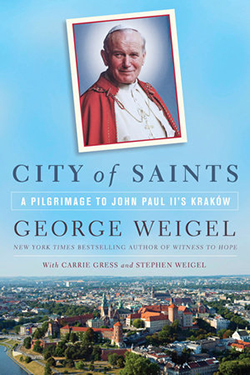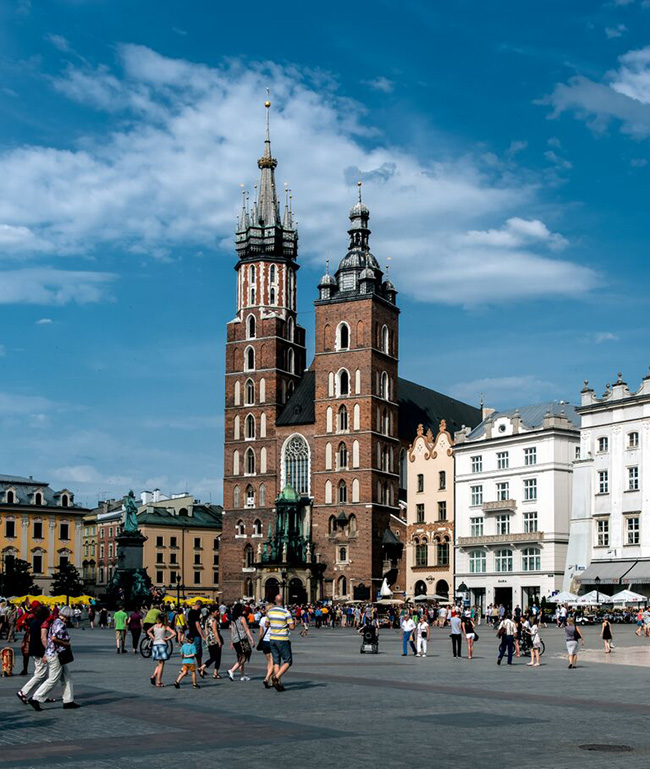Countdown to WYD: Mariacki Church and the Trumpeter of Krakow

May is a very special month in Poland. I only realized how special when I spent several months in northern Poland in the port town of Gydnia near Gdansk on the Baltic Sea. Every afternoon I joined my gracious hostess at the nearby parish; and every day the tiny church was packed with parishioners praying the rosary, signing hymns, and leaving flowers to honor Our Lady. It was just something everyone did at 4pm every afternoon for the whole month.
Although George Weigel and I covered the Basilica of the Assumption of Our Lady in City of Saints, it seemed remiss of me to blog about Krakow and not include this church of such intense, well, Polish-ness. And since it is May and Mary’s month, it seems fitting to read about it today.

Last week, I wrote about the Countess Franciszka Krasinska, whose remarks about the Mariacki reflect a timeless sentiment held by many Poles: “I find no such comfort anywhere as in the Church of Our Lady (the Mariacki). There is something there that touches my soul, something that brings me peace.”
“If there is a home for the Polish heart,“ Franciszka adds, “I believe it is in that church. All about me when I am there, the voices of all who have worshipped within its walls seem to be speaking to me and telling me to have courage. I think of the souls in pain that have come there for peace, and I think too, of those who lie beneath the slabs and monuments, their cares ended, their comfort come at last.”
In addition to the stunning polychrome interior featuring blues, golds and reds and the masterful altarpiece by Wiet Stoss depicting the Assumption of Our Lady, the church boasts another feature vital to the city: the trumpeter.
As I explained in City of Saints:
The Mariacki is also home one of Kraków’s most distinctive traditions, the hourly sounding of the Hejnal, a foreshortened trumpet call, every hour on the hour, to north, south, east, and west. Because of their height, the basilica’s towers were long used as watchtowers, the watchmen (who would sound the alarm by bugle) on the alert for fire or marauders. The Hejnal honors the memory of the watchful bugler who, while warning the city of an impending invasion in 1241, was struck in the throat by a Mongol arrow in midnote. Thus the Hejnal, which was the aural signature of the BBC’s Polish service during World War II, stops abruptly in midnote.
After the death of Pope John Paul II, a new tradition of trumpeting from the Mariacki was created. Each first Saturday of the month, at the precise moment of the Pope’s death (9:37 p.m. Central European Time), the Mariacki trumpeter sounds a Polish hymn in honor of Poland’s most distinguished son. (City of Saints, 203)
The trumpeter of Krakow became better known through the book of the same name by American author Eric P. Kelly. Kelly fell in love with Poland after his military experience with the Poles during the 1919-1920 Polish-Soviet War. Shortly thereafter, he took a professorship at Dartmouth University, where he remained a professor for 33 years. During that time, he became the first American exchange scholar at the Jagiellonian University in Krakow.
While Kelly wrote many books, The Trumpeter of Krakow is perhaps the best known, having won the Newbery Medal. Written for adolescents, the book is a fascinating read for anyone wanting to know more about the city and its history.
Later in his life, Kelly heard one of the old trumpets from Krakow was on tour in the United States. He arranged for the hejnal to be played at the grave of Polish national and American Revolutionary War hero Kazimierz Pulaski (1745- 1779) who died in battle in Savannah, Georgia. The trumpet, Kelly said, was likely the same one Pulaski heard played in the Rynek while growing up in Krakow.
The website of the Basilica of the Assumption of Our Lady offers a fantastic virtual tour of the church and also features the tune of the famous trumpeter.
Travel tip: Kneelers in Poland are slightly slanted, unlike those in the U.S. and most of Western Europe, which are flat. They are slanted so that you can rest against the seat of the pew while on your knees, relieving some of the pressure for the long stretches of prayer.
* * * * * * *
St. Mary's Church, or Kościół Mariacki, in Kraków (Photograph: Stephen Weigel)













